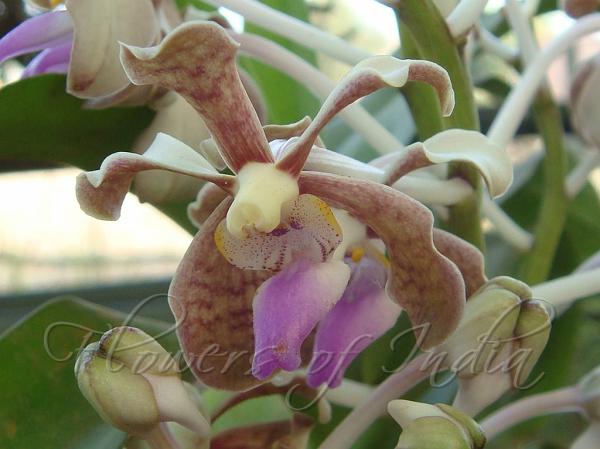|
| Bicolor Vanda |
|

|

| File size | 120497 |
| Original date | 2/27/08 2:04 PM |
| Resolution | 1024 x 768 |
| Flash | Flash did not fire, auto |
| Focal length | 6.33mm |
| Exposure time | 1/80s |
| Aperture | 3.5 |
| Focus Distance | |
| Metering Mode | Multi-segment |
| Camera make | SONY |
| Camera model | DSC-T20 |
| Sensor type |
|
|
|
|
Photo: |
Botanical name: Vanda bicolor Family: Orchidaceae (Orchid family)
Synonyms: Vanda stangeana
Synonyms: Vanda stangeana
The name "Vanda" is derived from the Sanskrit name
वन्दाका for the species Vanda tessellata. It is a small
sized orchid growing on trees, with a leafy stem enveloped almost
completely by leaf sheaths and each carrying oblong, curved leaves,
which are somewhat twisted in the middle, obliquely bilobed at tip, each
lobe 3-toothed. The plant blooms in the winter and spring on a hairless,
3-16 cm long, laxly 3 to 6 flowered inflorescence in leaf-axils, with
triangular floral bracts. It has flowers which are brownish with darker,
checkered marking, lilac at the throat. Flowers are 4-5 cm across;
sepals and petals decorated, yellowish-brown inside, violet externally,
lip violet and gold, spur white; flower-stalk and ovary slender, 4.8
cm long. Dorsal sepal obovate-spoon-shaped, tip rounded, margins wavy,
decorated behind, 2-2.1 x 1-1.1cm; lateral sepals similar, spreading,
2-3-2.4 x 1.3-1.4 cm. Petals are narrowly obovate-spoon-shaped, rounded,
margins wavy, decorated behind, 1.7-1. x 0.7-0.9 cm. Lip is 3-lobed,
spurred, 1.5 x 0.6 cm; laterals lobes broadly rounded to ovate, nearly
fused with the column base; mid-lobe internally. Column is round,
6 x 3.5 mm; anther cap flat, triangular, 3 x 2 mm. Bicolor Vanda is
found in eastern Himalayas, Bhutan and Myanmar in open forests and on
riverbanks at elevations 700 to 2000 m. Flowering: March-May.
| Identification credit: Pankaj Kumar | Photographed in Imphal, Manipur. |
• Is this flower misidentified? If yes,